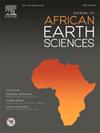Petrographical and geochemical insights into gabbroic rocks in ophiolitic occurrences from Kınık-Kütahya (Türkiye)
IF 2.2
4区 地球科学
Q2 GEOSCIENCES, MULTIDISCIPLINARY
引用次数: 0
Abstract
The ophiolitic rocks within the Tavşanlı zone offer valuable insights into the closure period of the Neotethys and subsequent geological processes. This study focuses on the petrographic and geochemical characteristics of gabbroic rocks from the Kınık Ophiolite in Kütahya, Turkey. Petrographic observations show that the main constituents of gabbroic rocks are plagioclase (labradorite, bytownite), orthopyroxene, clinopyroxene, and hornblende. Hydrothermal alterations such as uralitization, chloritization, and carbonization are commonly observed in ophiolitic rocks. The mafic rocks are part of a differentiated tholeiitic magma series, emphasizing their co-magmatic evolution within the context of the ophiolitic complex. Despite variations in Large Ion Lithophile Elements (LILEs; K, Sr, Rb, and Ba) due to low-temperature hydrothermal alteration (e.g., saussuritization of plagioclase, uralitization of pyroxene, and chlorite–prehnite vein formation), the geochemical signature of the Kınık gabbroic rocks suggests island arc tholeiitic (IAT) characteristics. Additionally, their rare earth element (REE) patterns strongly indicate a supra-subduction zone (SSZ) affinity. The development of the Kınık ophiolite, involving magmatic crystallization, occurred during the final stages of island arc evolution in the Neotethyan Ocean within a supra-subduction, fore-arc tectonic setting.
Kınık-Kütahya (trkiye)蛇绿岩产状辉长岩的岩石学和地球化学研究
tavanlyi带内的蛇绿岩为了解新特提斯期的闭合期和随后的地质过程提供了宝贵的见解。本文研究了土耳其k塔哈亚Kınık蛇绿岩辉长岩的岩石学和地球化学特征。岩石学观察表明,辉长岩的主要成分为斜长石(拉布长石、副长石)、正辉石、斜辉石和角闪石。在蛇绿岩中,通常观察到热液蚀变,如质朴化、绿泥石化和碳化。基性岩是分异的拉斑岩浆系列的一部分,强调了它们在蛇绿杂岩背景下的共岩浆演化。大离子亲石元素(LILEs)的变化(K、Sr、Rb、Ba)由于低温热液蚀变(如斜长石的闪石化、辉石化和绿泥石-前黑石脉的形成),Kınık辉长岩的地球化学特征具有岛弧拉斑岩(IAT)特征。此外,它们的稀土元素(REE)模式强烈显示出超俯冲带(SSZ)亲和。Kınık蛇绿岩的发育与岩浆结晶有关,发生在新特提斯洋超俯冲弧前构造背景下岛弧演化的最后阶段。
本文章由计算机程序翻译,如有差异,请以英文原文为准。
求助全文
约1分钟内获得全文
求助全文
来源期刊

Journal of African Earth Sciences
地学-地球科学综合
CiteScore
4.70
自引率
4.30%
发文量
240
审稿时长
12 months
期刊介绍:
The Journal of African Earth Sciences sees itself as the prime geological journal for all aspects of the Earth Sciences about the African plate. Papers dealing with peripheral areas are welcome if they demonstrate a tight link with Africa.
The Journal publishes high quality, peer-reviewed scientific papers. It is devoted primarily to research papers but short communications relating to new developments of broad interest, reviews and book reviews will also be considered. Papers must have international appeal and should present work of more regional than local significance and dealing with well identified and justified scientific questions. Specialised technical papers, analytical or exploration reports must be avoided. Papers on applied geology should preferably be linked to such core disciplines and must be addressed to a more general geoscientific audience.
 求助内容:
求助内容: 应助结果提醒方式:
应助结果提醒方式:


